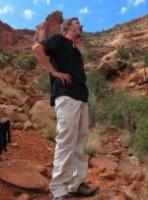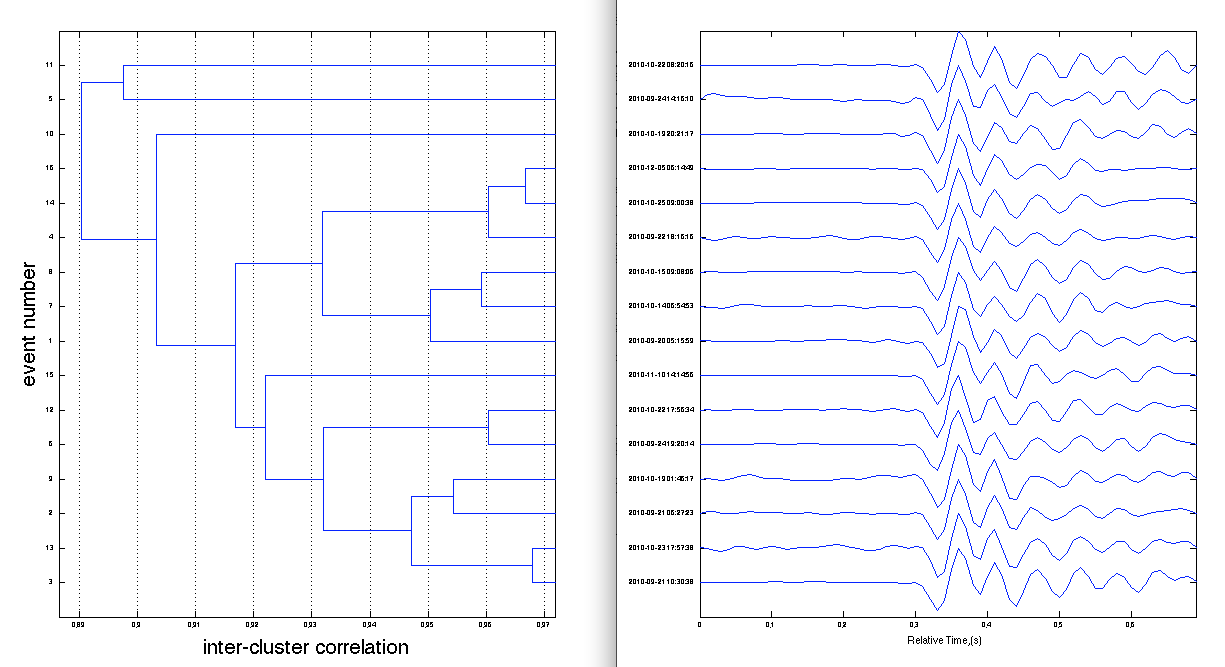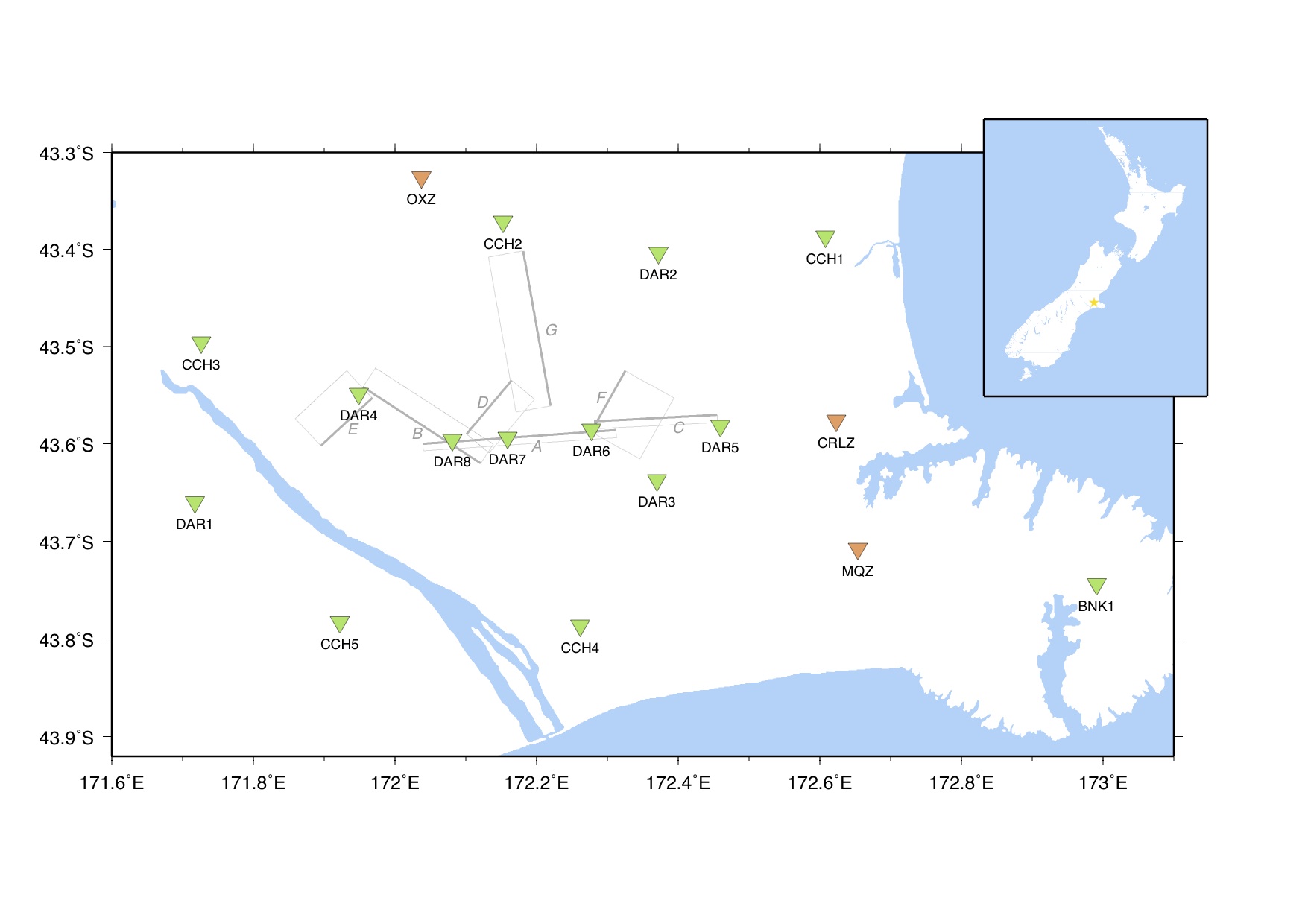Ryan Armstrong

Ryan Armstrong is a student at Colorado College currently completing his research at U. of Wisconsin-Madison under Dr. Ellen Syracuse.
The city of Christchurch was surprised in 2010 and 2011 by unknown fault segments in the Canterbury region. I will be examining aftershock waveforms in the Canterbury region to try to determine amounts of slip on specified fault segments by looking at small repeating earthquakes over time. These small repeating earthquakes can give insight into the evolution of fault stress after an earthquake.
Wrapping it all up and goals review
August 9th, 2012
Well, amazingly, I'm in my last two days of the ten-week internship. It feels like it blew by so fast. First I'll go through a review of my initial goals...
- Since I didn't have to write the codes for this project I would like to understand what it is they are actually doing (I think I'm part way there on this).
-I feel a lot more comfortable with most of the codes. Especially, the code for GISMO cross correlating. I never got a grasp of what the code for TomoDD, the earthquake location software, was actually doing, but I at least have a firm understanding of what goes into an earthquake location and how it is calculated.
- To understand the limits of the theory I am using. Does it over estimate or underestimate slip? Why? What does it actually tell us?
-This one is a little more vague than some of the others unfortunately. From what my experience, it seems difficult to know whether it is under or overestimating slip in a region. There is a the possibility for counting too many earthquakes, but possibly an even more likely chance of not counting all of them if we missed a group of repeaters. What it is actually doing is giving us a pretty localized estimate on afterslip rate, more effective at depth than geodetic methods like GPS or InSAR.
- How does the theory relate to seismic hazard in the area in and around Christchurch, NZ?
-This was a big one for me after my earthquake experience in Christchurch a little over a year ago. Although my project doesn't seem like it will support any direct hazard predictions, especially since my whole data set was before the Feb 21, 2011 quake, understanding afterslip rates on different fault segments is important for understanding stress build up and slip potential. If I'm really lucky, my work may give some sort of insight into why there was a second large event by the city after the 2010 rupture (the one I studied).
- I want to be good at producing good-looking figures by the end of this. :D GMT?
-I think this was my most successful area. I can now comfortably explain and tweak a GMT code I created from scratch in order to make the map I want with GMT. Review of the manual is always necessary, but I now have the knowledge to do all of that on my own!
Overall, this summer has been a wonderful experience both personally and academically. To be thrown into a new city with no friends at first seemed completely ludicrous, but after these ten weeks I would be completely okay with having to do it again. I had also never participated in research before this, and yet I am leaving with some GMT figures and a great data set to keep studying at Colorado College next semester. Who knows, maybe you'll see another blog post or two from me down the road.
Thanks to Michael, Katie, my advisor Ellen, and of course everyone else involved in this IRIS experience and my time at Madison. This experience will undoubtedly be priceless moving forward in my seismological career.
Cheers!
Ryan
Back with some EQ locatons
August 2nd, 2012
Now I finally have my earthquake locations to constrain repeaters more thoroughly than just by the shape of the waveform. Some of the families turned out with very similar locations such as the one below (segment C) and some did not. Overall, at first glance it looks like I should be able to make interpretations about which fault segments are more prone to repeating clusters and which aren't. In the map below, red earthquakes are at depths less than 5 km and yellow are between 5 and 10 km. Eventually, I will make some maps to show the temporal spacing of earthquakes within families as well.


Now that I have some idea of what my data looks like I'll be able to get a few drafts of my AGU abstract in!
Goals for the rest of the internship:
- Search for more repeaters on some of the fault segments that didn't appear to work so far.
- Run a program called HypoDD, which should allow me to get some sort of error bars on my map. (hopefully they aren't massive!)
- Get my abstract well-polished and turned in.
- Potentially, stack some of the families of waveforms to see how the families differ overall.
Cheers!
Ryan
Let’s do some interpretations!
July 30th, 2012
So finally I have my data set almost completely analyzed! Today I started the last step which is sorting my earthquake families and pick arrivals into the proper format and organization to run through the relocating program. The set up takes about an hour and the program should take a couple hours to run when I start it up tomorrow!
Next time I'm back on the blog, hopefully Thursday, I should have a fairly complete dataset to interpret and make some maps with! I will be having a meeting with my advisor on Wednesday to discuss what the scope of my interpretations will be based on how my data set comes out (fingers crossed). Sorry I don't have any cool figures to post now but some will be coming soon; I promise!
Wednesday night a couple friends from Colorado will be coming in to visit for a night. Glad to be merging the Colorado and Wisconsin groups finally! Be sure to enjoy the Olympics everyone, and for your entertainment from a Colorado College (:D) professor...
http://www.coloradocollege.edu/newsevents/newsroom/dan-johnson-the-man-who-predicts-medals
Cheers!
Ryan
First GMT figure and looking forward
July 19th, 2012
Thankfully, I think I am finally getting closer to having sorted through all of the necessary data to start getting interpretations. "Close" is definitely relative, but I feel closer to the end of it than the start now! After cross-correlating about one and a half more fault segments I will just need to finish picking my arrivals to calculate locations and the initial results!
On Tuesday I produced my first GMT figure, which is simply a fault map overlain by the station map used for my project. Fortunately I don't think many of the figures I will need to produce will be too much more complicated than this one, but that remains to be seen.

The weather is finally cooling off here. It rained almost all of last night and was about 71 degrees for my bike ride to work. After checking the temperatures for the last month I can confidently say that it has been over 3 weeks, maybe even more, since it has been that cool in the morning. Hopefully this will last a while. Back to picking arrivals!
Cheers!
Ryan
Picking Earthquake Arrivals!
July 12th, 2012
This week has been good so far; I've picked earthquake arrivals to find locations for two of my now eight families of repeating earthquakes. By the end of the day I hope to be done with the third and fourth.
The weather is finally cooling off a bit here (it's gotten down to the mid 80's a couple times), but is supposed to heat up to around the hundreds again over the weekend. :(
I realized that a few days ago I didn't specifically address my goals that I set forth at the beggining of the internship, which involved understanding the codes I am using, beginning to understand the limitations of the theory (and what it means to Christchurch), and being able to make good figures for the project. So here it goes...
- I am understanding how to use the codes and how they work very well for the most part. I will probably have a couple more to understand before it is all said and done, so I will have to revisit this later.
- I haven't yet had to make any figures with scripting, only GISMO-created plots. I should begin doing this in the next week or two with GMT however. So I will update you all on that.
- I think of these goals I have made the most progress on understanding the theory better. There have been a few instances where I have seen weaknesses in the theory's slip estimates just due to the methods of finding repeaters. But for me to gain a full understanding of how this affects the end result will require more knowledge about how the final data set turns out (after I get the locations and focal mechanisms).
At this halway point, I think I've made pretty solid progress on these three goals and am hopeful that the remaining weeks of my project will wrap them up nicely.
Cheers!
Ryan
Recognizing my successes
July 9th, 2012
Sorry I've been M.I.A. for a few days; the past week has been a rewarding albiet stressful one. I spent a good portion of the week continuing my cross correlations on a new fault segment. To date, I have discovered about 7 different repeating eathquake families on 4 different segments of the Greendale fault system. During a meeting with my advisor, we decided that since many of these earthquakes don't show up in the GeoNet catalog as events, I will need to find an earthquake location for most of them over the later portion of the internship. This will allow me to further determine which earthquakes are actually repeaters. Unfortunately, I haven't had much time to work with GMT yet to make figures, but once I have the new earthquake locations I'm sure this will be one of the next logical steps.
On Friday afternoon, we had an interesting seminar with Tiffany Lohwater, about the troubles of communication with non-science readers or listeners. The two areas that struck home most strongly with me, after a couple of poster presentations in Colorado, were not necessarily knowing the knowledge of your audience, and dealing with an audience of mixed experiences. These are issues that I never conciously thought about, which will hopefully help me out a lot in future presentations.
On the personal side, my parents came into town for the 4th of July! The were staying at a hotel only about a block from my house, so travel to and from Capitol square with them was very convenient. We got lots of good food, went to a great botanical gardern, and even got to watch a great fireworks right alongside the lake.
I'll be back to share more later this week!
Cheers,
Ryan
Business as usual
July 7th, 2012
This week has mostly been a continuation of cross correlating earthquakes on the second fault segment to try to find repeaters. I'm hoping that by this afternoon I will be able to move on to the next fault segment. Making progress!
On Monday I attended an awesome thesis defense, which analyzed the evolution of a Japanese subduction zone using an amazing set of seismic reflection data. After that I had a meeting with Cliff and some of his grad students so that we could all bounce ideas off each other. I was able to show a couple of the graphs that I made the week before in GISMO.
This week has been rough watching Colorado Springs be threatened so thoroughly by the crazy wildfires out west. Fortunately, our school hasn't been directly affected by the fire at this point, and it sounds like all of my Colorado friends had the same luck. But I'm off to Chicago this evening to visit a friend!
Beat the heat!
Ryan
Waveform comparison
June 21st, 2012
Well, yesterday I finally got to use GISMO, the program that takes in multiple waveforms and sorts them by similarity. By using this, I can identify the largest clusters of similar waveforms from the continuous data.
Here is a shot of what that program looks like...

As you can see, I've finally got some color in my life after looking at black and white waveforms for the first two weeks. Although I have yet to do any further analysis of the fault segment, the data I have now seems much more useful than it had been.
Of course, now that I got to this cool plotting part, it's time to go do it all over again on another fault segment! At least now I know what I'm doing and it should go a bit faster.
Over the weekend, a couple of friends and I drove up to Devil's Lake, Wisconsin to do a 3 mile hiking loop around the lake. I was thoroughly surprised by the extent of interesting geology in the area (this is the midwest after all). It was a nice change to actually be looking at rocks again, since my work is primarily computer-based. Here is a shot from the hike...

I'm going to a thesis defense tomorrow morning, so I'll be back with some more cool stuff next week!
Cheers,
Ryan
Starting up work in Madison
June 21st, 2012
The the IRIS Orientation was a blast. I got a lot more hands on experience with many of the programs I had merely been hearing about in my seismology class. We even had a short lecture in solving inverse modelling problems, which cleared up a lot of questions I had in my head since last semester. It's a bummer all the people from orientation won't be working together over the summer, but it seems like it will be a fantastic network of support when I'm struggling in any way.
I had a quick transition from plane to car in getting to Madison from the IRIS Orientation in Socorro, NM last weekend. Thankfully, everything went smoothly and I got moved in Sunday night in time to start work this past Monday.
The first day started off just looking at waveforms and picking out which looked good and which did not (and hopefully spotting repeating earthquakes) on one fault segment. Next I began writing control files and sorting SAC files into folders for the cross-correlation process which will eventually identify my repeating earthquakes. Once the earthquakes are identified we will hopefully be able to relate them to actual fault movement over time.
The city of Madison seems awesome. I was able to get a free "red bike" from a local bike shop for the summer. My roommates and I even got out to the terrace for an open mic night right at sunset on Tuesday.

Finally, goals for the internship...
- Since I didn't have to write the codes for this project I would like to understand what it is they are actually doing (I think I'm part way there on this).
- To understand the limits of the theory I am using. Does it over estimate or underestimate slip? Why? What does it actually tell us
- How does the theory relate to seismic hazard in the area in and around Christchurch, NZ?
- I want to be good at producing good looking figures by the end of this. :D GMT?
'Till next time,
Ryan
Week Two in Madison!
June 14th, 2012
So this week has been entirely focused on searching for repeating earthquakes on two specific fault segments near Christchurch. At first I wasn't having much luck at all, but with time I've gained an eye for which waveforms are most easily recognized by the scanning program in the continuous data. After getting what the computer says might be repeating earthquakes, I will have to sort through the quakes individually looking at the the data to determine if they are actually repeaters.
Here is an example of what the computer will spit out as possible repeaters...

I was having touble coming to grips with the importance of these repeating earthquakes at first, (especially because the idea of two earthquakes being the same sounds strange in itself due to the utter randomness of them) but after a discussion with my professor I realized that this is merely a simplification for identifiying as many similar earthquakes as possible within continuous data. By doing this we can more simply look at a large amount of earthquakes in a shorter amount of time.
My professor also showed me plots from a new program yesterday which will sort all these potentially repeating earthquakes into groups of coherence, thus showing which earthquakes are most similar to each other. By doing that I will be able to sort this broad group of "maybe reapeating earthquakes" into smaller groups of "likely repeating earthquakes." I haven't actually learned how to make these plots yet, but am definitely looking forward to the possibilities.
Life in madison has been laid back to say the least. I am enjoying my first opportunity to shop at Trader Joe's whenever I want and have made some great dinners as a result... plus I am probably eating much healthier than I usually do. I will have my first weekend in Madison this weekend since I was in Chicago last weekend, I will let you all know how it is next time.
Cheers!
Ryan


